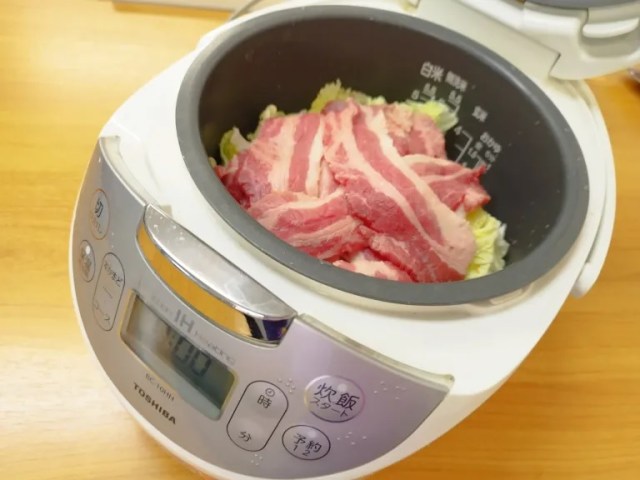
Today in the SoraKitchen, we attempt to make sukiyaki with zero ingredient cutting and just one button press.
With crisp fall weather on the way, our stomachs are already looking forward to one of our favorite comfort foods, hot pot. In particular, we’re looking forward to the king of Japanese hot pot dishes, sukiyaki. There’s really nothing quite like the joy of sitting around a table with a group of friends or family members, talking and laughing as you cook the ingredients bit by bit and share in the greatest act of selflessness, letting someone else know when a slice of meat or morsel of vegetable has been cooked to perfection and is ready to be eaten.
Unfortunately, a lot of that doesn’t apply to our Japanese-language reporter Seiji Nakazawa. While he does deeply love sukiyaki, Seiji lives by himself, and most nights of the week he eats dinner by himself too. So all that communal anticipation and excitement that comes from everyone pitching in to chop the ingredients plus the conversation as you wait for them to stew? Instead of those, Seiji just gets the hassle of doing all the prep work by himself, the tedium of watching the ingredients cook by himself, and then the additional hassle of scrubbing the large cooking pot when he’s done, again, all by himself.
And yet, Seiji still wants to eat sukiyaki, so he got to wondering if there’s an easier way to make it, at which point his thoughts turned to, as ours so often do here at SoraNews24, to rice cookers.
We’ve been surprised time and time again at how versatile these kitchen appliances are, and Seiji asked himself the question “Can I make sukiyaki by just tossing everything in a rice cooker and hitting the ‘cook’ button?”
So it was off to the grocery store to grab the essential ingredients, which were:
● Sliced beef strips (242 grams [8.5 ounces])
● A pack of sliced vegetables (Chinese cabbage, green onion, carrots,
● Sukiyaki broth (750 grams [26.5 ounces])
● Eggs
Remember, Seiji’s goal was to make sukiyaki while doing as little work as possible, so that’s why he went with the pre-sliced meat and vegetable packs. Once he was back from the store, Seiji opened up the lid of the rice cooker and tossed in all of the vegetables, all of the meat, and all of the broth (in other words, everything except the eggs, which, as we’ll see later, are actually an optional ingredient).
Then he closed the lid, hit the “cook” button, and went back to thinking about video game ninja girls.
▼ “Hmm…I still think Mai’s costume should tear…”
45 minutes later, the rice cooker’s cook cycle was done, and it was time to check the results.
Though this was Seiji’s first time to try to make sukiyaki this way, we’ve cooked enough non-rice things in our rice cooker that we were fairly confident that the ingredients would be cooked and, at the very least, edible. Our biggest concern was what would happen to the broth. As a hot pot, sukiyaki is supposed to still have broth while you’re eating it, and its moist mix of savory and sweet flavors makes an excellent complement to a bowl of white rice. If you think about what happens when you use a rice cooker for its original intended purpose, though, you start by filling it with rice and water, and once the cooking cycle is done the water is entirely gone, having been absorbed into the rice or spouted off as steam. So would the same thing happen with Seiji’s sukiyaki, leaving him with a pile of steamed meat and veggies but no broth?
Nope! Popping open the lid, Seiji saw that not only was everything cooked, he still had plenty of broth!
With the scent of sukiyaki now wafting up and filling the room, Seiji excitedly plated a sample to taste…
…and it was delicious! Not only had the rice maker made sukiyaki, it had made really good sukiyaki, with everything full of flavor, despite the fact that Seiji hadn’t so much as cut a single ingredient or given the pot a single stir to get this meal ready.
This is where the eggs come into play, as in Japan it’s common to crack a raw egg into a dish and use it as a dipping sauce when eating sukiyaki. This isn’t something that everyone does, though, and depending on where you are in the world eating raw egg may or may not be something you’re comfortable doing, or something that’s medically advisable due to local egg supply and handling protocols. Seiji, though, here in Japan where eating raw egg like this isn’t considered dangerous or unappetizing, is happy to report that rice cooker sukiyaki goes just as well with raw egg as sukiyaki made the more traditional way does.
As an added bonus, since rice cookers are designed to keep the rice warm after it’s finished cooking, ours also kept Seiji’s sukiyaki warm as he was eating, at a nice, moderate temperature that kept the flavor fresh without scalding his tongue.
If you’re a sukiyaki veteran, you might have noticed that there are a few common ingredients, like mushroom and tofu, that we didn’t use in this experiment, Now that we know how good the baseline results are, we’re looking forward to sprucing up our rice cooker sukiyaki with things like those as we get deeper into fall, and hopefully they’ll turn out just as well as our simple version here. For now, though, it’s great to know that we can make sukiyaki with just the press of a button.
Photos ©SoraNews24
● Want to hear about SoraNews24’s latest articles as soon as they’re published? Follow us on Facebook and Twitter!
[ Read in Japanese ]